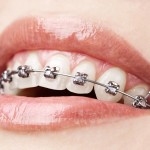
The aim of this study was to compare intermolar widths after alignment of crowded mandibular dental arches in non-extraction adolescent patients between conventional and self-ligating brackets.
The trial included patients requiring non-extraction treatment in both arches, having all mandibular teeth erupted with no spaces in the mandibular arch, mandibular irregularity index from canine to canine greater than 2 mm, and no therapeutic intervention planned involving intermaxillary or other intraoral or extraoral appliances including elastics before the end of the observation period.
Patients were randomized to receive either a conventional appliance, or a passive self-ligating appliance, both with a 0.022-in slot.
The amount of crowding of the mandibular dentition at baseline was assessed by using the irregularity index. Intermolar width was investigated using a linear regression analysis. On an exploratory basis, the effect of appliance type on intercanine width was also assessed. Additionally, the effects of appliance type on time to alignment and crowding on time to alignment were assessed by using the Cox proportional hazards model.
The authors found no evidence of difference between the two bracket systems in terms of
- intermolar width (β = 0.30; 95% CI, -0.3 to 0.9; P = 0.30)
- intercanine width (β = 0.33; 95% CI, -0.8 to 0.1; P = 0.15)
- the time to reach alignment (hazard ratio, 0.68; 95% CI, 0.4 to 1.2; P = 0.21).
Whereas the amount of crowding was a significant predictor of the required time to reach alignment (hazard ratio, 0.88; 95% CI, 0.8 to 0.9; P = 0.02).
The authors concluded
The use of conventional or self-ligating brackets does not seem to be an important predictor of mandibular intermolar width in non-extractions patients when the same wire sequence is used.
Pandis N, Polychronopoulou A, Katsaros C, Eliades T. Comparative assessment of conventional and self-ligating appliances on the effect of mandibular intermolar distance in adolescent nonextraction patients: A single-center randomized controlled trial. Am J Orthod Dentofacial Orthop. 2011 Sep;140(3):e99-e105. PubMed PMID: 21889063.
